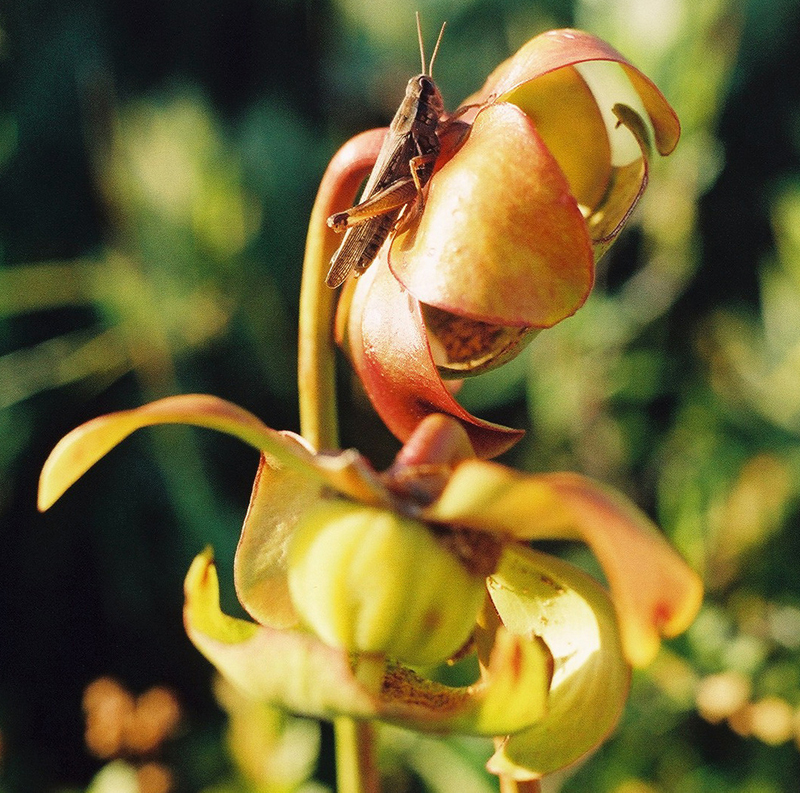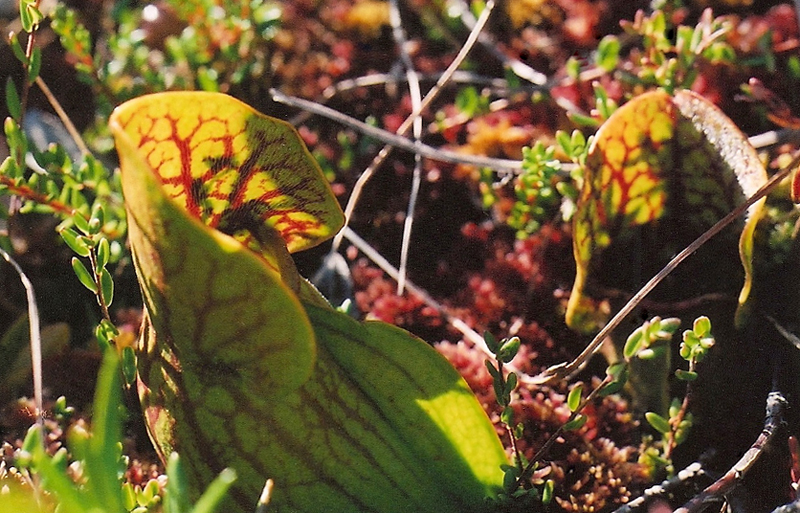
Purple Pitcher Plant
aka: Northern Pitcher Plant, Frog Britches, Huntsman's Cap, Side-Saddle Plant, Turtle Socks, Smallpox Plant
Sarracenia purpurea ssp. purpurea
Sarraceniaceae


A native carnivorous plant species found in sphagnum bogs, this species has distinctive pitcher-shaped leaves, and produces a large, showy and unique nodding red and yellow flower on a tall leafless stalk (May-August). The rigid five-part flower loses its petals very quickly, but otherwise stays almost entirely the same as seeds form in a capsule and ultimately fall. The leaves range from green with red veining to almost entirely red-purple in the fall and winter, and grow in a basal cluster of pitchers open to the weather, collecting rainwater in their cups. Fine, recurved hairs at the tops of the pitchers send insects tumbling into the water inside the leaves, where these unlucky insects are broken down by naturally-occurring bacteria, helped along by a few digestive enzymes provided by the plant. The plant makes use of the nutrients released by this process to supplement the poor availability of nutrients in the soil conditions it favors. Tolerates highly acid soil, and particularly favors sphagnum bogs, although it may also be grown in clay, loamy, or sandy soils. Not generally tolerant of droughts, these plants are also quite sensitive to the salts of chlorinated water and fertilizers. Purple Pitcher Plants form a vigorous, spreading clump when their growing conditions are met, and the only part of the plant that truly gets tall is the flowering stalk. Along with the fact that this species is insectivorous, it also has a fascinating relationship with the community of microorganisms that develops within the water held inside the pitchers - these microorganisms may in fact help with the breakdown of insects that have fallen into the pitcher plant's trap and assist the plant by helping turn the bodies of the insects into absorbable nutrients. What's more, there are multiple species of insect that actually breed in the pitcher plant's water, including a (non-pest!) mosquito species (Wyeomyia smithii, also known as the Pitcher Plant Mosquito; they're fascinating, look them up!) which breeds only in the cups of this plant, a species of midge that also only breeds in these plants (Metriocnemus knabi, the Pitcher Plant Midge), and a genus of fly (Fletcherimyia, the Pitcher Plant Flies). The larvae of these insects feed on the microorganisms inside the pitchers, creating a tiny, rich ecosystem that assists the plant itself. This plant also has an interesting history; people have long been fascinated by this strange species, as evidenced by its numerous names - it's also seen many uses through the years, including as a treatment for smallpox, which earned it the name Smallpox Plant. Overall, an extremely fascinating species that is fun to grow (if you don't have the correct conditions on your property, you can always look into creating a bog in a large pot or whiskey barrel) and well worth the hype. Like all carnivorous plants however, wild collection for the hobby trade and habitat loss threaten this species, so never ever purchase a carnivorous plant without first verifying that it was not collected in the wild. Like all of our plants, we propagate and grow these plants from seed here on our farm, and will never collect plants of these species from the wild.


1-3 foot tall
Plant Hardiness Zones:
Zone 3a-8b
Perennial
Native Range: ME south to GA, west to MN. Also native in WA. Native to Canada in BC, AB, SK, MB, ON, QC, NL, NB, PE, and NS. Considered Rare in DE, MD, VA, NC, GA, OH, IN, IL, and WA.
Germination - Easy:: Cold stratify 4 weeks.
Review or Finalize Your Order
